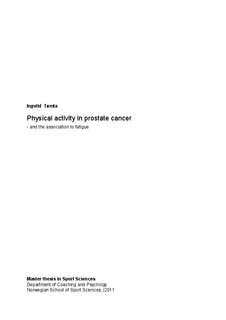| dc.description.abstract | Aims: In the present study the aims were to examine the level of physical activity
(PA) before diagnosis (retrospectively) and after treatment in prostate cancer
survivors. Another aim was to examine changes in level of PA after treatment
compared to before diagnosis. Further aims were to investigate the relationship
between level of PA before diagnosis and occurrence of cancer-related fatigue after
treatment, and the association between level of PA after ended treatment and cancerrelated
fatigue after treatment.
Methods: Three hundred and twenty-one prostate cancer survivors aged between 56
and 80 years (M = 68.5, SD = 5.24), and localized staged (T1-T3) were included in
this cross-sectional study. They completed a questionnaire including question about
demographic variables, physical activity and fatigue. Physical activity was assessed
by Godin Leisure-Time Exercise Questionnaire at two moments of time (before
diagnosis (retrospectively) and after treatment (at present time when filling out the
questionnaire). Fatigue was assessed by Fatigue questionnaire.
Results: Fourty-five % completed the questionnaires. 41 % of the participants were
physically active before diagnosis, whereas 44 % were physically active after
treatment. 12 % was physically active before diagnosis but inactive after treatment,
whereas 17 % were inactive before diagnosis and active after treatment. Being
physically active before diagnosis was associated with lower fatigue post treatment
(p < .05). Being physically active after treatment was also significantly associated
with lower fatigue scores post treatment (P<.05).
Conclusion: Less than half of the prostate cancer survivors reported to be physically
active both before diagnosis and after treatment. The majority had the same activity
level at the same time points. Being physically active was associated with having less
fatigue, both before diagnosis and after treatment. | no_NO |
